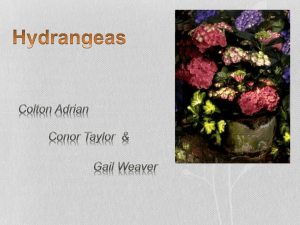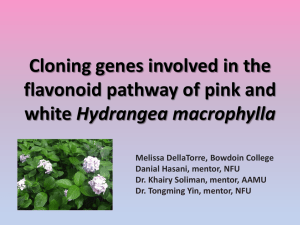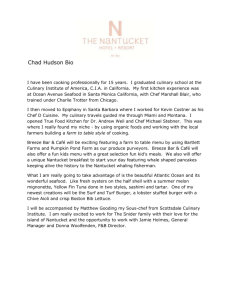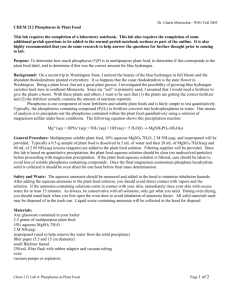Basic Information Full Name: UC ID #: UC Email: Phone: College
advertisement
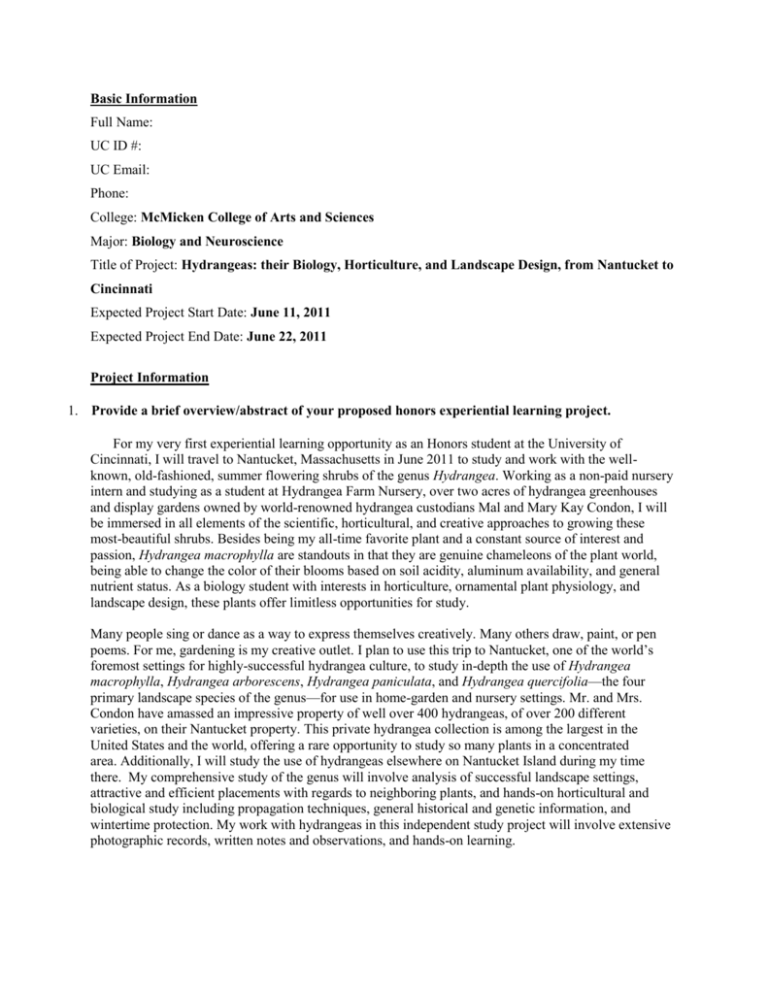
Basic Information Full Name: UC ID #: UC Email: Phone: College: McMicken College of Arts and Sciences Major: Biology and Neuroscience Title of Project: Hydrangeas: their Biology, Horticulture, and Landscape Design, from Nantucket to Cincinnati Expected Project Start Date: June 11, 2011 Expected Project End Date: June 22, 2011 Project Information 1. Provide a brief overview/abstract of your proposed honors experiential learning project. For my very first experiential learning opportunity as an Honors student at the University of Cincinnati, I will travel to Nantucket, Massachusetts in June 2011 to study and work with the wellknown, old-fashioned, summer flowering shrubs of the genus Hydrangea. Working as a non-paid nursery intern and studying as a student at Hydrangea Farm Nursery, over two acres of hydrangea greenhouses and display gardens owned by world-renowned hydrangea custodians Mal and Mary Kay Condon, I will be immersed in all elements of the scientific, horticultural, and creative approaches to growing these most-beautiful shrubs. Besides being my all-time favorite plant and a constant source of interest and passion, Hydrangea macrophylla are standouts in that they are genuine chameleons of the plant world, being able to change the color of their blooms based on soil acidity, aluminum availability, and general nutrient status. As a biology student with interests in horticulture, ornamental plant physiology, and landscape design, these plants offer limitless opportunities for study. Many people sing or dance as a way to express themselves creatively. Many others draw, paint, or pen poems. For me, gardening is my creative outlet. I plan to use this trip to Nantucket, one of the world’s foremost settings for highly-successful hydrangea culture, to study in-depth the use of Hydrangea macrophylla, Hydrangea arborescens, Hydrangea paniculata, and Hydrangea quercifolia—the four primary landscape species of the genus—for use in home-garden and nursery settings. Mr. and Mrs. Condon have amassed an impressive property of well over 400 hydrangeas, of over 200 different varieties, on their Nantucket property. This private hydrangea collection is among the largest in the United States and the world, offering a rare opportunity to study so many plants in a concentrated area. Additionally, I will study the use of hydrangeas elsewhere on Nantucket Island during my time there. My comprehensive study of the genus will involve analysis of successful landscape settings, attractive and efficient placements with regards to neighboring plants, and hands-on horticultural and biological study including propagation techniques, general historical and genetic information, and wintertime protection. My work with hydrangeas in this independent study project will involve extensive photographic records, written notes and observations, and hands-on learning. Upon completion of this unique work-study opportunity, I plan extensive dissemination of all that I have learned and enjoyed. I will write a minimum 10-page retrospective study of the use of genus Hydrangea plants in home-garden and nursery settings with particular focus on their usefulness in Coastal New England and potential extensions to use here in Southwest Ohio. I also will prepare a visual presentation of my experience and findings that can be shared with university students including honors scholars, faculty, UC Garden Club members, landscape professionals, nursery owners, and the interested public. 2. Clearly state how each of the following elements will be exhibited in your work (refer to the first two pages of this document with the full description of what is expected in each of these areas). 1. Substantial Content and Quality within Research Theme While maybe not something normally considering as “creative arts”, gardening and landscape design can serve as great avenues for creative thought, planning, and expression. The perceived merit of hydrangeas in garden settings is unfortunately not well-spread beyond the East and West Coasts and the Deep South. However, based on my experiences and observations, they make exceptional garden plants almost anywhere with careful planning, siting, and maintenance. There use in gardens is terribly underestimated here in Ohio due to our alkaline soils and icy winters. I know how much satisfaction, creativity, and growing success they have afforded me and I hope through a week-and-a-half immersion in the art and science of hydrangea culture that I can spread their unique chracteristics and potential garden value here in the Midwest. Studying and working with these plants on Nantucket, with worldleaders in their field, I will be ready for bountiful learning and meaningful observation with regards to the four major landscape species: H. macrophylla, H. arborescens, H. paniculata, and H. quercifolia. Mr. and Mrs. Condon’s personal collection of over 400 hydrangea specimens in a variety of settings with a variety of garden cohorts will provide ample study opportunities, notwithstanding an entire island where hydrangeas are grown in abundance due to their corresponding summer bloom time and ease of culture in the acidic, sandy soil that Nantucket affords. Since gardening successes are very experientially based, I will have unparalleled access to two internationally-recognized authorities in the hydrangea community. Their unique insights, techniques, and years of experiences will prove invaluable in my acquisition of hydrangea knowledge and eventual dissemination of what I have learned. I am particularly well-positioned to share my experiences and new expertise provided my position as President in the University of Cincinnati Garden Club. 2. Connection to Academic Goals and Theories I am majoring in biology and am strongly leaning towards pursuing a concentration in plant biology. Although I am planning to pursue a career in medicine, I continue to consider careers and graduate education in horticulture, plant biology, landscape design, and/or nursery plant production. Regardless of what I end up choosing to do after I graduate from the University of Cincinnati, participating in a high-quality immersion experience in the study of a particular genus of organisms directly connects to my undergraduate biology degree, especially if I decide to specialize in plant biology. I hope to participate in on-campus research in the near future, possibly with one of UC’s plant biologists in a research program through the greenhouse at Rieveschl Hall. This 10-day long hydrangea experience, although involving more of the “creative” side of horticulture, will provide me with invaluable skills in plant propagation and assessment that could be extrapolated to a more “serious” scientific study. I have been gardening since as long as I can remember and likewise have held a lifelong appreciation and fascination for biological systems; these two passions can easily mesh out in the yard. Sometimes I wonder to myself what exactly was the impetus for me to become interested in growing hydrangeas? Definitely my East Coast background provided the inspiration, provided the sheer beauty and ease of growing hydrangeas in the acidic soils by the Atlantic Ocean. However, I believe that it is the unique ability of Hydrangea macrophylla flowers to turn blue, purple, or pink—depending on soil conditions—that piqued not only my creative gardening interests, but my concomitant scientific interests as well. Accordingly, in my own garden, I have hydrangeas that represent that continuum of shades and hues from deep cornflower blue to vibrant ruby red. A struggle that all gardeners face when planning a new flower bed is getting the colors right. It is very convenient, albeit somewhat expensive and slow, to change the flower color of these shrubs based on the unique preferences of individual gardeners. To prepare myself for this independent study project, I have begun reading in great detail several key texts written about hydrangeas including Hydrangeas for American Gardens, by famed horticulturist Dr. Michael Dirr, the very comprehensive Encyclopedia of Hydrangeas by CJ and DM Van Gelderen of the Netherlands, and Hydrangeas by Glyn Church of the world’s foremost gardening nation: New Zealand. Also, I am preparing for my first-time on Nantucket by reading Nantucket by Robert Gambee, a longtime summer resident of the island, Fodor’s Pocket Nantucket from the Fodor’s travel book series, and Guide to Nantucket by Polly Burroughs. I am using these books to become familiar with the island before getting there, including identification of prospective gardens and settings in which I want to observe the utilization of these plants. Although I will miss the prime bloom period by about three weeks, all shrubs will be fully-leafed out and expressed with buds during the time I will be on the island. The successful culture of any plant does not necessarily require inspection of the flower; comparable information can be elucidated by leaf coloration, plant size, the buds themselves, and the age and general vigor of the plant. Also, Mr. and Mrs. Condon have an extensive photo database that I could use to study the blooms on specific specimens from previous summers. 3. Initiative, Independence and Creativity I will be demonstrating exceptional independence and creativity in this project. To be precise, this is an entirely independent project and accordingly will be an excellent learning experience for a science major such as myself. I have already demonstrated considerable initiative in that I proposed this experience to Mr. and Mrs. Condon who offer a somewhat-similar “summer camp” experience in July, August, and September for a fee. However, that summer camp is largely lecture-based. This self-designed project features a very high level of “dirt under your fingernails” experiential learning, amplifying my potential educational benefits. Given my passion for these plants and an insatiable desire to share the hobby of gardening with others, this experience is of high personal importance and interest. Based on what I learn in Massachusetts, I will extrapolate my experience to address the process and techniques of masterfully growing hydrangeas here in Southwest Ohio. On account of my passion to share both general gardening and hydrangea gardening in particular, I will be spending a considerable amount of time this summer preparing both my formal report and presentation for dissemination upon return to the university in September. From what I have researched, no such study has been done quite like this before, from gaining invaluable insight from a renowned hydrangea nursery in a unique environment (Nantucket) to addressing specific hydrangea-growing concerns pertaining to a small geographic area (Southwest Ohio) from their light and water requirements to their successful placement with neighboring plants, again with a focus on gardening vagaries specific to our region of the country. In sum, this is a novel project that is essentially 100% independent, studying a unique topic with very specific implications. 4. Reflection & Dissemination I am looking forward to extensive dissemination of my Nantucket hydrangea experiences and learning. Upon completion of the travel component of this independent project, I will begin writing a minimum 10-page formal report highlighting and detailing my newfound knowledge regarding hydrangea culture. The bulk of this report will be framed around my in situ photographs and written observations from the island. I also plan to include notes and photographs from my own hydrangea collection at my residence in Miamisburg, Ohio to use in comparison with Nantucket and my eventual hydrangeagardening recommendations for Southwest Ohio. Additionally, I want to prepare an informative and illustrative PowerPoint presentation that can be shared with University Honors students, members of the University of Cincinnati Garden Club, faculty, other students, and the public-at-large. I also foresee the possibility of sharing my report and/or presentation with landscape and nursery professionals in the Tri-State area if the interest arises. I am most excited about the possibility of implementing a hydrangea display garden at the UC Garden located at the UC Early Learning Center, which the University of Cincinnati Garden Club is participating with. I cannot think of anything better than physically demonstrating my knowledge garnered from my experiences with Mr. and Mrs. Condon at Hydrangea Farm Nursery. Since our garden club is rapidly expanding and the campus-wide recognition of the UC Garden is growing, I believe that possibilities will exist soon for major expansions of the UC Garden and/or implementation of entirely new gardens located elsewhere. It would be a fitting culmination for this experiential learning project to include actual demonstration of successful and ideal hydrangea conditions to gardeners here in Ohio. 5. Advisor (list the person’s name, title, and contact information) Mr. Mal Condon and Mrs. Mary Kay Condon 86 Madaket Road Nantucket, Massachusetts 02554 hydrangeafarm@comcast.net 6. Budget (if applicable) $161. 40* One-way air transportation (Dayton Int’l to Boston Logan Int’l) $250.00 (Estimated) One-way air transportation (BOS to DAY) NOTE: My return date is flexible and will depend on weather, date of incoming “Hydrangea Camp” attendees the following week, and how much I do not want to leave Nantucket $50.00^ Roundtrip ground transportation between Logan Airport and Hyannis, Cape Cod $35.00 # Roundtrip ferry transportation between Hyannis and Nantucket $150.00 (Estimated) Food (breakfast and lunch will be provided by the Condon Family) $50.00 (Estimated) Personal items (incl. sunblock, bug spray, toiletries, etc) $35.00 (Estimated) Nantucket hydrangea plant to begin UC Garden hydrangea collection --------------------------------------------------------------------------------------------------------------------$731.40 TOTAL *-denotes item already purchased (AirTran Airways) ^-bus tickets are purchased onboard (Plymouth & Brockton Bus) #-ferry tickets are purchased directly at the Steamship Authority terminal in Hyannis I will take great care so as to avoid any cost overruns on the return airfare. As explained above, there are significant costs associated with simply getting from Boston’s Logan Airport to the island and vice versa (ferry and bus). Nantucket DOES have an airport serviced by Continental, Delta, US Airways, and Cape Air. While unlikely, it may be possible to return home by flying directly out of Nantucket Memorial Airport rather than going all the way to Boston Logan. However, I would exercise that option only in the event that it would be more cost-friendly. In the event that I am under-budget at the end of my stay, I would like to purchase multiple plants for the prospective hydrangea collection at the UC Garden. Nantucket is an expensive place (it IS an island 30 miles at sea) but with careful planning, I hope to make this ~10 day experience quite economical.
